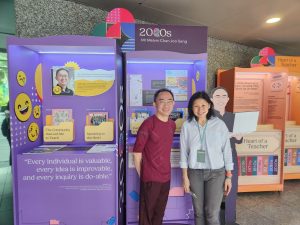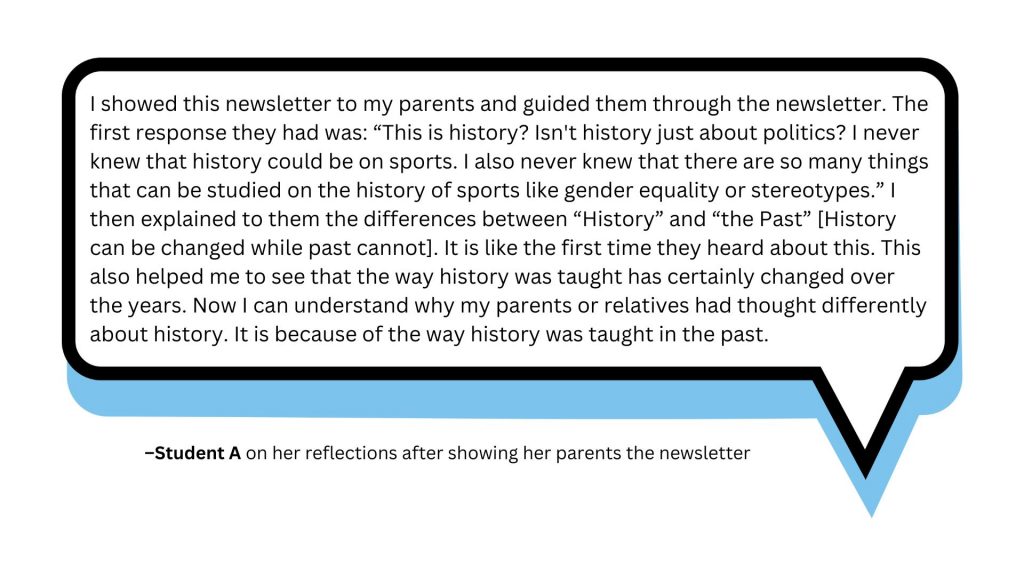Why Singapore’s English Teachers Should Embrace Singlish, Not Fight It
Is it time for Singaporean educators to embrace Singlish as a legitimate learning tool? What the Research […]
Read More
Progressive pedagogies emphasize that education should be an active and constructive process for learners. Key characteristics of progressive pedagogies include student-centredness, and inquiry-based and interdisciplinary learning. How can such approaches be applied to the way history is taught and learnt? In this issue of SingTeach, Mr Melvin Chan, Lead Teacher (History) at Chua Chu Kang Secondary School, shares more about the school’s signature History programmes that place students at the heart of the learning process.

Melvin and Dr Teo Chew Lee, Senior Research Scientist at NIE’s Office of Education Research, at the “Heart of a Teacher” exhibition held at the MOE Heritage Centre. The exhibition offers a sneak peek into the lives of eight real-life teachers in Singapore – one for each decade from the 1950s till today – to uncover inspirational and heartwarming stories centred on teacher identity (“Heart of a Teacher”). For more information on the exhibition, visit the website: go.gov.sg/hoat
There is a misconception that learning history is all about accumulating and memorizing facts about the past. Mr Melvin Chan, Lead Teacher (History) at Chua Chu Kang Secondary School (CCKSS), wants to change how society perceives History as a subject.
“It is important that society, including our young learners, understand history through the lens of its philosophical nature, historiographical changes and interdisciplinary discourse,” he says.
A conversation with a History colleague from Clementi Town Secondary School on the teaching and learning of history sparked an idea of a cross-collaboration project between teachers and students of both schools.
“We had a common interest to promote students’ collaborative agency towards disciplinarity growth and mastery of history,” he explains. “After many brainstorming sessions, we embarked on a programme called ‘The History Times’, where students are tasked to produce a history newsletter and share their findings, approaches and masteries to the community.”
“Centrality of students’ voices refers to putting student voices at the heart of the lesson, culture of build-on refers to students gathering data and exercise reasoning, while course of rising above refers to students engaging in reflective thinking.”
– Melvin defines the 3Cs
Progressive approaches to education prioritize learning through experience and place students at the centre of the learning process. At CCKSS, all History lessons are grounded in the social constructivist approach, with inquiry-based learning – strongly supported and anchored by Knowledge Building (KB) pedagogy – as well as elements of collaborative and crossover learning infused into the way teachers teach History.
“CCKSS has adapted and localized the 12 KB principles into 3Cs – ‘Centrality of students’ voices’, ‘Culture of build-on’ and ‘Course of rising above,’” Melvin states.
“Centrality of students’ voices refers to putting student voices at the heart of the lesson, culture of build-on refers to students gathering data and exercise reasoning, while course of rising above refers to students engaging in reflective thinking,” he adds.
With these pedagogical underpinnings in mind, the combined History team from both schools engaged in a few rounds of initial dialogue and conversation to come up with a lesson plan for “The History Times” programme. They conceptualized the 4Cs of “Connect, Comprehend, Conceptualize, Create”.
Students present a historical figure in their preferred mode. They then use the KB scaffold in the Knowledge Forum, an online platform to facilitate KB inquiry, and rethink their ideas. Based on their revised interests, students are grouped accordingly. Since this activity is conducted online, teachers from both schools create a Zoom platform and facilitate ice-breaker activities.
Students engage in curated activities, such as conducting historical research and attending guest speaker sessions, with teachers guiding them toward a deeper understanding of the topic they are researching on.
In each of their groups, students start building on their ideas, conceptualizing and theorizing to develop a unifying theme that synthesizes their diverse perspectives. Each group shares the progress made on the Knowledge Forum and cross-group collaboration is encouraged. Teachers are on hand for online consultations and feedback.
Each group creates their own history newsletter and submits a draft for peer review by another group. After incorporating the necessary revisions, the teachers conduct a final review. Once approved, the newsletters are ready for presentation.
“This programme is open to all interested Secondary 3 History students, including those from the Express and Normal Academic streams as well as those taking Core History and Elective History. We usually take in a maximum of 20 student participants with 5 teachers in charge,” he elaborates. “For 2023, the newsletter focused on the theme ‘The Interwar Period’.”
Unlike traditional approaches to teaching and learning, progressive education regard knowledge as dynamic, shaped by context and arises through the learning process. Melvin is heartened to see that students are capable of not only going beyond memorization of historical facts, but also equally competent in stepping out from the perspectives of hindsight and concept of determinism.
“When the students presented their ‘The History Times: The Interwar Period’ newsletter, they were able to deduce that ‘Every historical period deserves to be studied on its own’ and ‘The Interwar Period should not be overshadowed by the idea of wars’. This shows that they can understand that history is never static and that historians should not practice determinism when analysing historical period,” he says.
He also emphasizes that teachers should not underestimate youths’ adaptability to new learning approaches as well as their cognitive advancement. He advocates adopting a less didactic pedagogical approach to the teaching and learning of history, with a focus on incorporating diverse perspectives into the curriculum.
“This project shows that students are capable of effectively using the KB scaffolds to advance their group’s historical knowledge and understanding. These series of cognitive build-ons facilitate the various moves towards the integration of historiography and an interdisciplinarity approach to each group’s inquiry theme,” he remarks.
The success of this programme has inspired other teachers in the school to adopt aspects of progressive pedagogies such as KB and crossover learning in the subjects they teach.
“It is important to crystallize the key essences of the pedagogical mechanisms underlying these approaches so that colleagues will not feel overwhelmed,” he advises. “Distilling the KB principles into the 3Cs, for instance, simplifies the approach and builds confidence among teachers.”
Moving forward, Melvin hopes to scale up the cross-community history work. “Our team hopes that more cross-collaborations with colleagues from the history fraternity will occur,” he shares. “We are also in the midst of integrating Artificial Intelligence (AI) into the formative feedback and build-on process.”
“This project shows that students are capable of effectively using the KB scaffolds to advance their group’s historical knowledge and understanding. These series of cognitive build-ons facilitate the various moves towards the integration of historiography and an interdisciplinarity approach to each group’s inquiry theme.”
– Melvin, on why we should not underestimate youths’ adaptability
